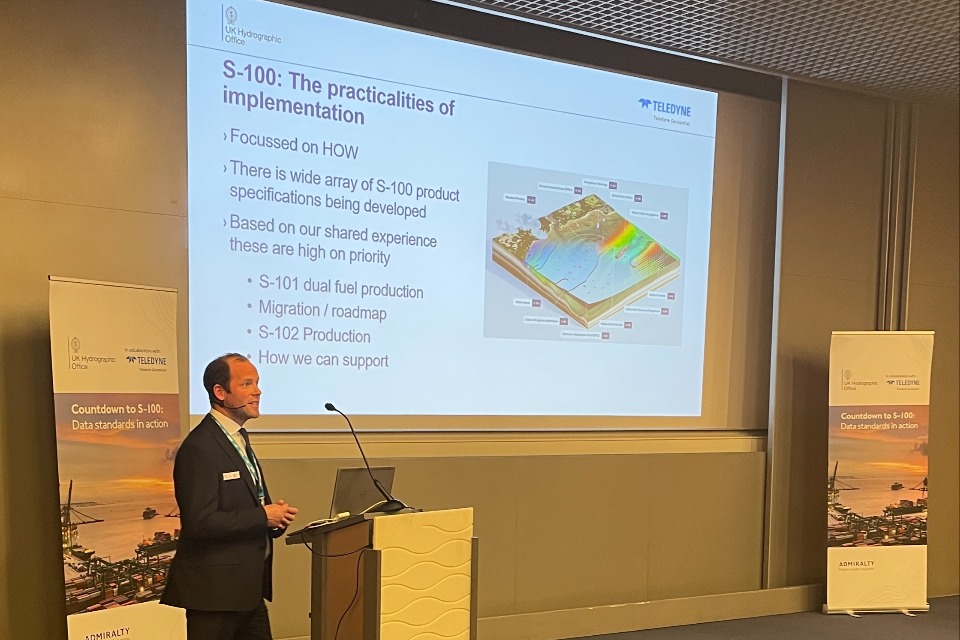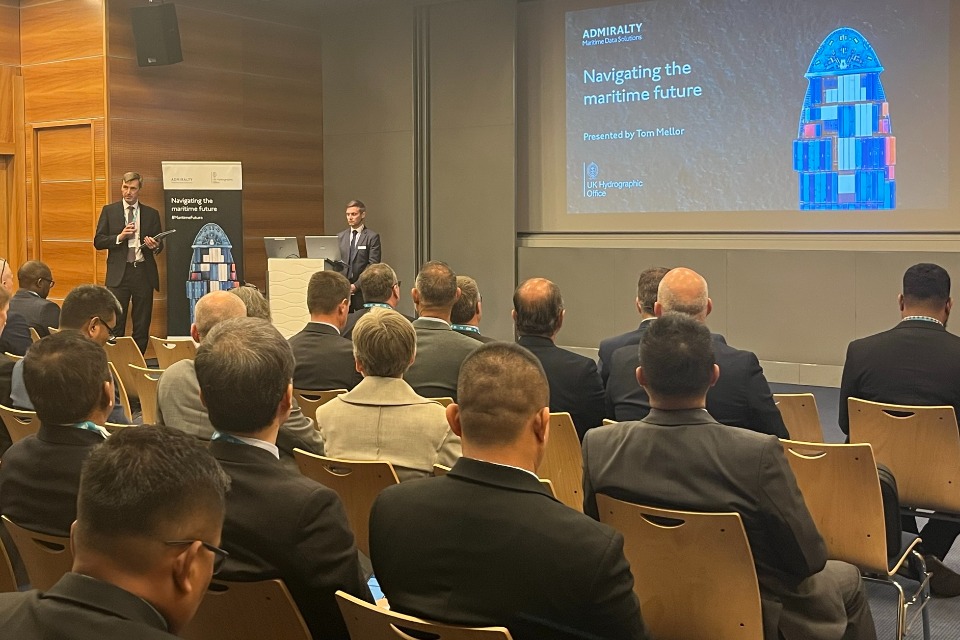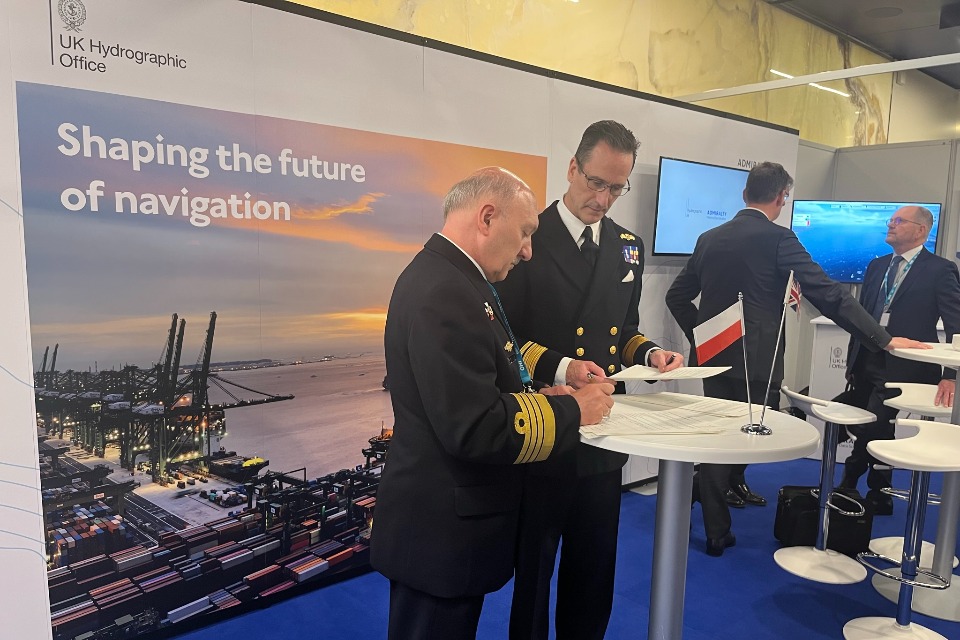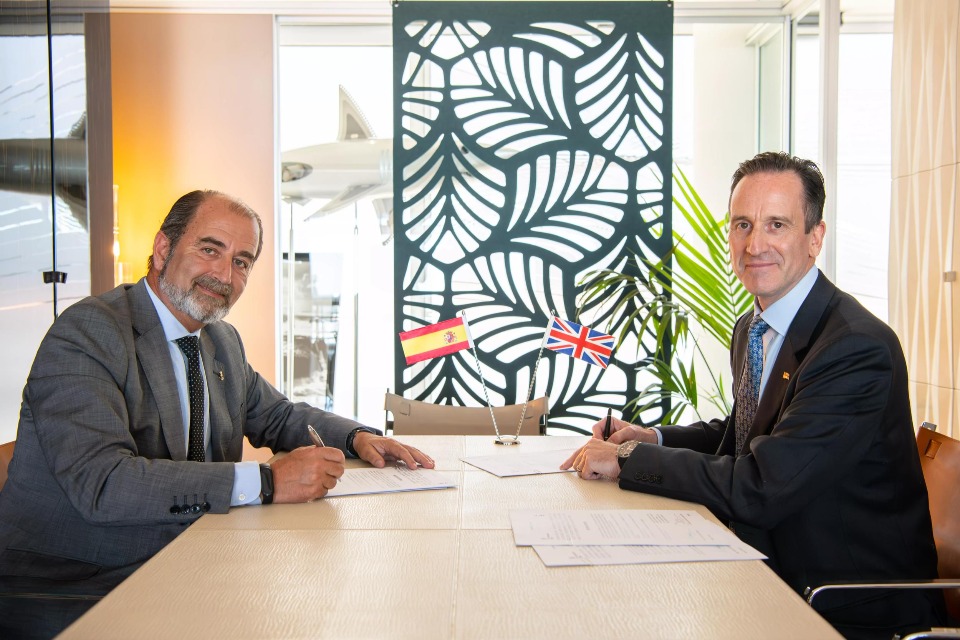At the beginning of May, several representatives from UK Hydrographic Office (UKHO) attended the 3rd Session of the IHO Assembly in Monaco. The Assembly is formed by the representatives of the IHO's 98 Member States and meets every three years to provide strategic guidance on the functioning and work of the organisation.
The Assembly is an important venue for international hydrographic collaboration, and the week provided us with the opportunity to engage and collaborate with our peers and colleagues from around the world.
A royal welcome
The focal point of our week at the Assembly was our stand in the exhibition hall. On the stand, we had several experts on hand from our partnering and engagement teams, as well as technical experts and members of UKHO's leadership team. UKHO representatives were on hand to discuss the sharing and management of hydrographic data, including our involvement in the development and implementation of S-100 standards.
The stand also featured an interactive demo of our digital twin, providing a virtual model of Southampton and Portsmouth with dynamic data feeds such as AIS data, tidal heights, weather data and more. These data feeds allow the model to accurately replicate conditions in real time and simulate a range of scenarios. These digital twins will support innovation across the maritime industry and help pave the way for emerging autonomous technologies.
The technology on display was so popular that even Albert II, Prince of Monaco, stopped by to give it a try.
Highly engaging lunchtime seminars
During IHO Assembly 3 the UKHO held two lunchtime seminars. The first, 'Countdown to S-100: Data standards in action', was hosted in collaboration with Teledyne CARIS. The session shared our collective experience of the practicalities of S-100, our roadmap for its implementation, and provided a demonstration of S-101 and S-102 in action.

James Cooke, Head of Digital Delivery presenting at the Countdown to S-100 seminar
We also explored some of the drivers and challenges associated with S-100, including how autonomous data collection and improved sensors will increase the amount of data at our fingertips, but also require us to process and verify that information in near or real time.
Meanwhile, our second seminar - titled 'Navigating the maritime future' - saw us explore digitalisation and new technology development, including a particular focus on how we can build cybersecurity into S-100 products from day one, to ensure that new technology development does not expose our industry to disproportionate risks.

Speakers and attendees at the Navigating the maritime future seminar
Both seminars were well attended and saw a great deal of engagement, with many productive conversations arising during the seminars and afterwards as a result.
Focus on partnering and engagements
Because the IHO Assembly draws in participants from around the world, each meeting provides us with a brilliant opportunity for our partnership and engagement teams to sit down with our international hydrographic counterparts.
The session was perfectly timed for the newly appointed HoPE (Head of Partnerships and Engagement) for Europe and the Mediterranean (EM) Nick Rodwell, to meet the majority of the EM representatives. Nick also supported in the facilitation of Poland signing a new bilateral agreement with the UK, one of the many successful additional activities which were completed during the margins of the event.

UK National Hydrographer signing bilat agreement with Poland
The strong attendance of the UKHO's counterpart national hydrographic office partners at the IHO Assembly also provided an ideal opportunity to sign a Print On Demand (POD) Arrangement with the Spanish Hydrographic Office (Instituto Hidrográfico de la Marina).
The signing took place at the Monaco Yacht Club between RAdm Rhett Hatcher and the Director General of IHM, Commander Salvador Espinosa Gonzalez-Llanos. The signing of the POD Arrangement will assist IHM with the provision of paper charts to the Spanish Navy.

Director General of IHM, Commander Salvador Espinosa Gonzalez-Llanos, and RAdm Rhett Hatcher sign the POD Arrangement
The UK constructively engaged and provided input on the topics and significant issues discussed during the plenary meetings at Assembly. Key decisions agreed included amendments to IHO resolutions on the use of gender inclusive language, recognition of the Southern Ocean, and establishment of new project teams to look at alternative funding for capacity building and consider the establishment of an S-100 infrastructure centre.
Progress on Electronic Chart System (ECS) activity
As mariners transition to digital navigational products, hydrographic offices have an obligation to ensure their official digital charting is available to all vessel types navigating in their waters. However, the current IMO regulations focus on ECDIS-capable vessels and do nothing to address the large market of vessels that are less than 10,000 GT in tonnage and that were constructed before 1 July 2013.
Currently, non-ECDIS vessels are, in most cases, using unregulated Electronic Chart Systems in combination with unofficial electronic data products, and carry paper charts to meet carriage requirements.
To maximise the safety of navigation in national and international waters, hydrographic data should be used as widely as possible on all digital navigational displays. However, the regulations, standards and infrastructure required to use hydrographic office data in systems below the ECDIS mandate are currently not in place.
This year's IHO Assembly provided a critical venue to discuss this important issue, with the UKHO seeking for the creation of a working group to recommend how this gap can be filled, allowing for regulated and approved use of hydrographic office data on non-ECDIS vessel equipment.
The ultimate objective is a solution for all non-ECDIS vessels that can negate the need for any users to have to carry paper products in the future and allow them to fully embrace the advantages of digital navigation.
The proposal for a project team to be formed to investigate requirements for ECS will be discussed at the upcoming IHO Hydrographic Services and Standards Committee meeting this week.
Evening reception conversations
Finally, the UKHO also hosted an evening reception during the Assembly week, with our CEO Peter Sparkes delivering a speech on our perspectives on the future of hydrography. That speech touched on several key elements - most chiefly among them S-100 - and the impact that the new data standards will have on the hydrographic community. Exploring a range of factors such as HD Electronic Navigational Charts through to what can be achieved via digital twinning, Peter shared his belief that the future of hydrography has never been more exciting.

Peter Sparkes delivering his speech to attendees at the UKHO evening reception
Peter reiterated the UKHO's commitment, as the UK government's hydrographic and marine geospatial experts, to focusing on shaping the future of navigation. He shared our thoughts on how the whole hydrographic sector, and indeed how hydrographers gather, deploy and present data, must evolve if we are to support the evolving needs of our users, and particularly mariners, across the globe.
All in all, this year's IHO Assembly was both productive and engaging, and gave us the perfect opportunity to discuss the exciting future for the global hydrographic community. We are looking forward to more opportunities for collaboration, particularly on developing issues like sub-ECDIS, in the coming days, weeks and months.






